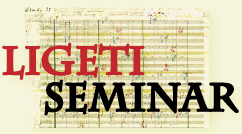5) The Seventies; Historicism, Minimalism and the Fantastic
More orchestral works, teaching at Stanford, Le Grande Macabre, short works of the late ‘70s influenced by American minimalism.
For week 6
Read
György Ligeti, "On My Piano Concerto," trans. Robert Cogan, Sonus 9/1 (1988), 8–13.
György Ligeti, Preface, Simha Arom, African Polyphony and Polyrhythm, trans. Martin Thom, Barbara Tuckett, and Raymond Boyd (Cambridge: Cambridge University Press, 1985), xvii-xviii.
Amy Bauer, The Singular Exotic (Chapter 5) and Lament and the Absolute (Horn Trio, Chapter 6), Ligeti’s Laments: Nostalgia, Exoticism and the Absolute (Aldershot, UK: Ashgate), 2011.
Denys Bouliane, "Ligeti's Six Études Pour Piano: The Fine Art of Composing Using Cultural Referents," trans. Anouk Lang, Theory & Practice 31 (2006), 159–208.
Listen
Radio 5: The Seventies: Historicism, Minimalism, the Fantastic
Analyze for May 14
10 Pieces for Wind Quintet, No. 3, (1968)
Questions here as Word doc. As pdf
Further Reading
Paul Griffiths, Minimalism and Melody, Modern Music and After (Oxford: Oxford University Press, 2010)
György Ligeti and Claude Samuel, "Ligeti– Claude Samuel" (1981), in Ligeti in Conversation with Péter Várnai, Josef Häusler, Claude Samuel and Himself, trans. Terence Kilmartin (London: Eulenburg, 1983), 111–23.
István Szigeti, "A Budapest Interview with György Ligeti," The New Hungarian Quarterly 25 (1984), 205–10.
György Ligeti and John Rockwell, "Laurels at Auspicious Time for György Ligeti," The New York Times (Nov. 11 1986)
György Ligeti and Dorle J. Soria, "György Ligeti: Distinguished and Unpredictable," Musical America 107:4 (1987), 12-25, 27.
Edwards, Nicole N., "Ligeti's Etudes pour piano, (premier livre): A Fusion of Tradition and Experimentation," Musicology Australia 24 (2001), 62–84.
David Metzer, Chapter 4, Lament, in Musical Modernism at the Turn of the Twenty-First Century (Cambridge: Cambridge University Press 2009), 144–74.
Aluas, Luminata, "Visible and Audible Structures: Spatio-Temporal Compromise in Ligeti's Magyar Etüdök," Tempo 183 (1992), 7–17.
Clifton Callendar, “Interactions of the Lamento Motif and Jazz Harmonies in György Ligeti’s Arc-en-ciel,” Integral (2007), 1-25.
Hartmuth Kinzler, "Decision and Automatism in ‘Désordre,’ 1re Étude, Premier Livre," Interface 20 (Journal of New Music Research 20:2) (1991), 89–124.
Michael Searby, “Ligeti’s ‘Third Way’: ‘Non-Atonal’ Elements in the Horn Trio,” Tempo 216(Apr 2001), 17-22.
Stephen A. Taylor, “Chopin, Pygmies, and Tempo Fugue: Ligeti's "Automne a Varsovie,” Music Theory Online 3/3 (1997, and “Ligeti, Africa and Polyrhythm,” the world of music 45/2 (2003), 83-94.
Work List
Melodien for chamber orchestra (1971) LL
Double Concerto (1972) LL
I. “Calmo, con tenerezza,”
II. “Allegro corrente”
Clocks and Clouds (1972-73)
San Francisco Polyphony for orchestra (1974)
Three Pieces for Two Pianos (1976) LL
I. “Monument,”
II. “Selbstportrait mit Reich und Riley (und Chopin ist auch dabei),”
III. “Bewegung”
Hungarian Rock for harpsichord (1978)
Passacaglia Ungherese for harpsichord (1978)
Le Grande Macabre (1974-77; rev 1996)
Mysteries of the Macabre three arias from Le Grande Macabre for trumpet and piano (arr. Elgar Howarth) (1988) LL
 print
print